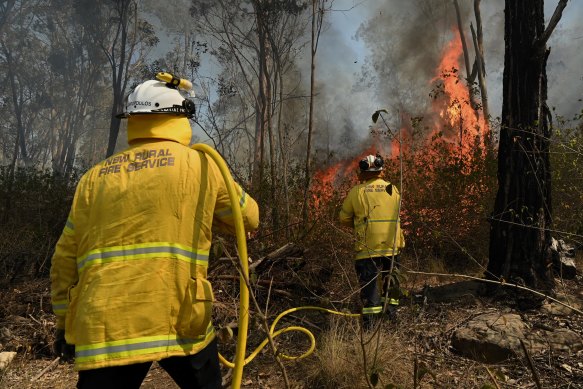Save articles for later
Add articles to your saved list and come back to them any time.
New South Wales and Victoria have struggled to meet their hazard reduction targets ahead of this year’s bushfire threat, Federal Emergency Management Minister Murray Watt said, but he promised that government co-ordination had improved since previous years’ disasters and there were now additional aircraft to fight fires from the sky.
With record September temperatures and fires already ablaze along the eastern seaboard, Watt said the federal government was also examining its role in disaster response and whether part-time paid firefighters or national community service was needed in future to deal with longer and more intense bushfires.
NSW Rural Fire Service workers control a bushfire from a property in Wallacia last week.Credit: Kate Geraghty
“Australia is much better prepared for this coming season than we were heading into Black Summer. We have implemented almost all of the recommendations of the bushfire royal commission that were made to the federal government,” Watt said on the ABC’s Insiders program on Sunday.
“They include establishing one coordinated national emergency management agency, rather than two separate organisations under two separate ministers which existed before.”
He said the federal government had doubled its spending on aerial firefighting since Black Summer and had an additional large water-bombing aircraft, as well as more helicopters. Between the Commonwealth, states and territories, he said there were about 500 aircraft available for this fire season, which is more than at any other point.
Ahead of a two-day bushfire summit in Canberra – which will begin on Monday and bring together representatives from the public sector, firefighting services, community organisations and the private sector – Watt said state authorities had assured him their firefighting capacity was sufficient to deal with the summer ahead.
They had also been doing their best regarding hazard reduction burns, but had been limited by wet weather brought by almost three years of La Niña weather patterns, he said. The Bureau of Meteorology declared an El Nino weather pattern – which brings hot and dry summers – last week.
“My understanding is that Queensland has reached its targets for fuel reduction heading into this summer, but states like New South Wales and Victoria, where we have had incredibly heavy flooding over the last year or so, it has been more difficult,” Watt said.
“No-one can guarantee that we won’t be facing risk. There will always be risk in a country like Australia, but we certainly are doing everything we possibly can to be prepared.”
Long-term preparation will also involve planning which personnel should respond to disasters when they strike. A recent government review found the Australian Defence Force – which has been frequently called upon to deal with floods, fires and recovery in the last three years – should only be used as a last resort because it detracts from their core duties.
Watt said his government would always make the ADF available when they were needed, but they should not be “first port of call”. The Department of Home Affairs last month opened a public consultation on the issue.
“It is possible in the future that we will have the need of turning to semi-professional firefighter services, like they have in California, where people can … be paid just for the fire season, rather than the entire year,” Watt said.
A national community service is also under consideration, although Watt said he did not want to commit to forcing people to participate. “It might be possible to do it in a voluntary manner, such as we do with the Army Reserve,” he said.
“It might also be about supporting the states and territories with building up their numbers of volunteers because I do think we need to be cautious about having the federal government overstep its area of responsibility… But the fact is we are facing a difficult changing climate and we need to be ready and thinking differently.”
The Morning Edition newsletter is our guide to the day’s most important and interesting stories, analysis and insights. Sign up here.
Most Viewed in Politics
From our partners
Source: Read Full Article

